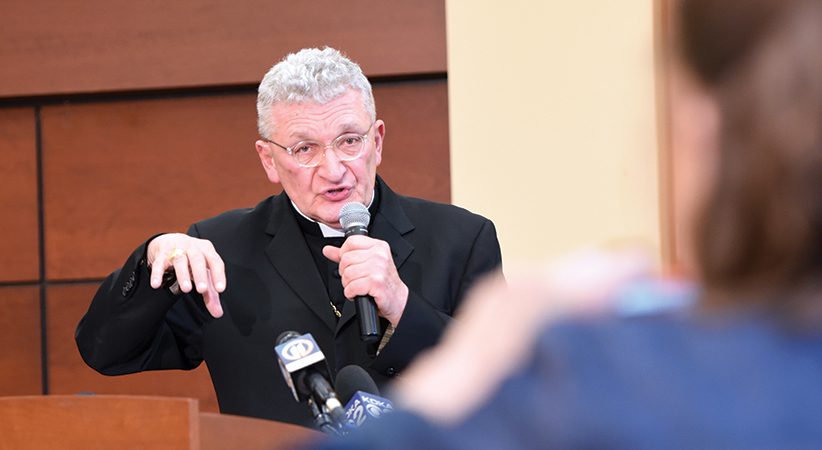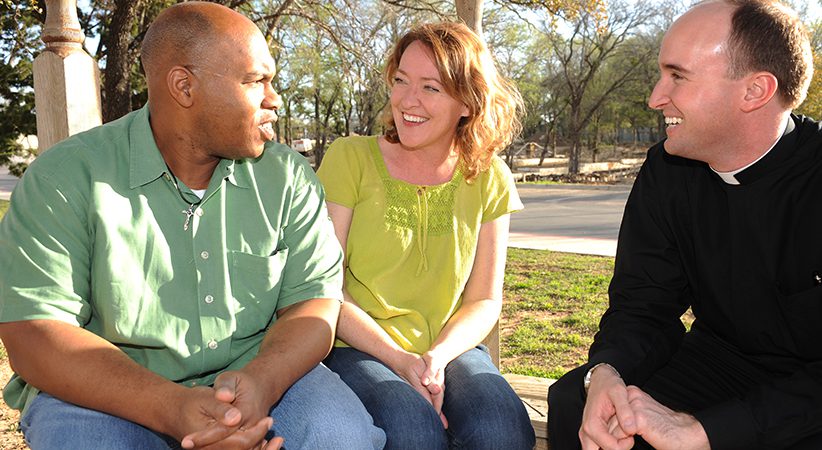Why Young People Are Leaving the Church
Everett Fritz Comments Off on Why Young People Are Leaving the Church
I grew up in the suburbs south of Chicago, and, as a result, I am a fanatical Cubs fan. If you are even a mild baseball fan, you know that the Chicago Cubs won the World Series in 2016, and it was a big deal because it was their first championship in 108 years. It was a huge news story not just because it ended the suffering of fanatical Cubs fans like myself, but also because the Cubs’ victory broke the famous “curse of the billy goat.”
The famous story of the billy-goat curse goes something like this. The last time the Cubs had won the pennant was in 1945, and they went on to lose the World Series that year. During the World Series, William Sianis — the owner of Billy Goat Tavern — bought two tickets for one of the games at Wrigley Field. As his guest, Sianis brought his pet goat, Murphy, to the game. Because the goat was bothering fans, both Sianis and Murphy were evicted from the stadium. William Sianis was furious and allegedly sent a telegram to the Cubs’ owner, Philip K. Wrigley, which read: “You are going to lose this World Series and you are never going to win another World Series again. You are never going to win a World Series again because you insulted my goat.” The Cubs didn’t play in another World Series until 2016.
The Cubs franchise tried everything to break the curse. Several years, on opening day, they admitted a goat into the stadium and paraded him around the field. A priest was allowed into the stadium to perform an exorcism. A severed goat’s head was sent as a gift from fans to the new team owner, Tom Ricketts. You might say the only thing that the Cubs didn’t try was putting a good baseball team on the field.
When new ownership took over the Cubs, they brought in new leadership to think differently around the problem. They overhauled their player development, scouting departments and analytics. One of their final steps to remake the franchise was to hire Joe Maddon as the team’s manager.
Maddon has a great baseball mind, and he had been around the sport for several decades. But he definitely was a bit quirky. In particular, he had a reputation for doing unorthodox things to keep his team motivated. One of my favorite stories was that, when the new ownership renovated the Wrigley Field locker room, they asked Joe what he wanted. He told the owner that he wanted a “celebration room” so that the team could throw a party every time they won a ball game. The Cubs celebrated like they won the World Series after each victory because Joe wanted his team to look forward to winning and to fight for each victory. The celebration room in the clubhouse has a DJ booth, smoke machines and strobe lights.
I love this story, because it demonstrates that, in order to accomplish a seemingly impossible task, we have to be willing to think differently around the problem and even be willing to do things considered unorthodox.
………………………………………………………………………………………………………………………………………………..
How to Talk to a Young Person
A couple of years ago I was in a conference room addressing the presbyteral council of a diocese. I went through my brief presentation on discipleship and then opened the floor up for questions. I was surprised when the priests in the room wanted advice on how to start a conversation with a young person. The priests were from an older generation and felt that they couldn’t relate to today’s young people. Because of this, many of them expressed a fear of engaging with young people.
This problem is more common than you think. Too often, I think we can psyche ourselves out by thinking we have to be immersed in a culture in order to be able to relate to it. We fear what we don’t understand, and this can become an excuse to fail to engage with people outside of our comfort zone. Regardless of age, gender, race or religion, everyone has something to share with another. The most fundamental way to engage in a conversation with others is to ask some variation of “share your story with me.” With young people, this can be as simple as asking them about themselves and what brings them to church.
When the apostles shared the Gospel with others, they frequently spoke first about what they had seen and heard. Witness — both hearing others’ witness and sharing our own — is essential for sharing the Gospel. It is also a great starting point for any relationship that may grow into discipleship.
…………………………………………………………………………………………………………………………………………………..
Losing Young People

In the Catholic Church we have no shortage of impossible tasks to accomplish. I would argue that the most alarming problem in today’s Church is the loss of young people. We have all seen the statistics, and there is no other way to put it: The Catholic Church is in a battle for the souls of our youth, and the Church is losing. In fact, it’s a massacre. If we don’t reverse the trend of losing young people, many Catholic parishes will be empty within one generation.
Despite the fact that this is a huge problem in the Church that needs immediate attention, it is amazing to me how few Catholics can articulate the reason why young people are leaving. When I pose the question to Catholics, I will frequently hear the problem articulated with a preconceived solution in mind.
These are some of the arguments that I hear frequently repeated:
• “Young people don’t know the teachings of the Faith. If they understood the depth of our faith, they would be active and engaged Catholics. The solution is more or better catechesis.”
• “Parents don’t take the Faith seriously. They drop their kids off at our programs and don’t come to Mass. The solution is more formation for parents.”
• “The culture is to blame for young people leaving the Church. The secularization of society is driving young people away. The solution is to renew Catholic culture.”
• “The Church doesn’t care about young people. Ministry to the youth is not a priority. The solution is more funding for youth ministry and Catholic education.”
• “Young people leaving the Church is the fruit of the Second Vatican Council. The solution is to restore the liturgy to the extraordinary form.”
• “Young people themselves are to blame. [I have actually heard this argument.] They are lazy and disrespectful, and they do not question greater life questions. The solution is to give up on most young people and only focus on the youths who express interest in living a life of piety.”
At best, these statements reflect the symptoms of a larger problem. At worst, these statements are nothing but excuses. I could easily argue the opposite of each of these statements:
• There has never been a time when we have had more quality catechetical resources and programs than we have right now in the Church. These programs and resources are used in many Catholic parishes and have not stopped the hemorrhaging of young people. The root of the problem is not poor catechesis.
• No one cares more about their children than their parents, and if the Faith wasn’t of importance a parent wouldn’t drop their child off at the church at all. It is true that the personal witness and piety of many parents is lacking, but the apathy of parents can also be an indication of their opinion of the quality of the ministry offered for themselves and their children. Parents are not the core of the problem.
• Historically, the culture has been against the Church more than it has been in support of the Church, and arguably the Church has been at its worst when the culture supports it. The culture is what it is, and it does not change our responsibility to evangelize. The culture is not the problem.
• Virtually every Catholic parish offers some kind of programming or formation for children and youths. The Church invests millions of dollars into Catholic education. We have large conferences, camps, mission trips, pilgrimages and many other opportunities for youths to engage in their church each year. While budgets could be bigger for youth ministry, a lack of effort in presenting ministry for young people is not the problem.
• Vatican II did not bring about a lack of piety in the Church. On the contrary, the council exposed the lack of piety in the Church. While young people are certainly attracted to truth, beauty and the sacred, believing that restoring the liturgy to the extraordinary form is the solution to all of our problems is downright delusional.
• Young people are full of passion, they want to change the world, they are innovative thinkers, and they are seeking purpose, identity and mission. They are clay that has not yet been molded. A youth movement in the Church is exactly what we need.
No Silver Bullet
There is no silver bullet to fix the problem of young people leaving the Church, because all of these proposed solutions seek to fix the problem while working within existing ministry constructs. The system is broken and is unfixable. The reason young people are leaving the Church is because their basic needs are not being met within existing ministry structures. Formation structures within the Church are obsolete. They were created to meet the needs of a different generation living in a different age of the world. Consider what Pope Francis says in Christus Vivit:
“Youth ministry, as traditionally carried out, has been significantly affected by social and cultural changes. Young people frequently fail to find in our usual programs a response to their concerns, their needs, their problems and issues. The proliferation and growth of groups and movements predominantly associated with the young can be considered the work of the Holy Spirit who constantly shows us new paths” (No. 202).
According to Abraham Maslow’s Hierarchy of Needs, a person will not move to a point of “self-actualization” unless their basic needs are met. For our purposes, we want young people to make a commitment to become lifelong followers of Jesus Christ and his Church. They are not making this commitment because their basic needs are not being met in the Church. In order to fix this problem we need to be willing to burn down the ministry constructs that have built and begin anew to develop ministry that actually ministers to them where they are.
I have been working in youth ministry for 16 years, and I work all over the country evaluating and helping parishes rethink their youth ministries. The only parish ministries that I see thriving and developing long-lasting fruit are those that have rebuilt youth ministries with discipleship as the foundation of what they do. It makes sense that to fix a seemingly impossible problem we have to return to the way that Jesus did ministry.
………………………………………………………………………………………………………………………………………………….
Small Groups and Discipleship are Not Equal
“Discipleship” and “small groups” are hot buzzwords in the Church right now. Discipleship is when a small number of handpicked students live with a rabbi and learn from his daily example. The goal of discipleship is shared living and imitation of the rabbi. For our purposes, discipleship can most accurately be described as “an apprenticeship in Christian living.”
In today’s Church, I have met many who assume that small group ministry in a parish automatically translates into discipleship. I’ve seen many parishes attempt to launch small groups with little guidance or purpose, and they simply hand them a program to follow and call it “discipleship.” These groups eventually peter out having no real direction or purpose. There has to be intentionality and vulnerability within the relationships in the small group for true discipleship to occur.
Many small groups are centered on breaking open and discussing a lesson. Programmed content isn’t a bad thing, but programs don’t make disciples. No parish leader can take the resources provided by [insert popular program] and automatically make lifelong followers of Jesus Christ by simply running the program. Resources and programs are merely tools that can assist in developing healthy discussions within a mentoring relationship. A discipleship-focused small group is centered on relationships, witness and imitation. If a group wants to reap the benefits of discipleship, it is essential to have intentionality in the relationships they establish.
…………………………………………………………………………………………………………………………………………………….
Sermon on the Mount

AdobeStock
In my book “The Art of Forming Young Disciples” (Sophia Institute Press, $14.95) I mention that too many ministries today operate with a Sermon-on-the-Mount mentality. In his Sermon on the Mount, Jesus gave a long series of teachings to a great number of people. It is considered the greatest sermon Jesus ever gave. However, nowhere in the Scriptures does it say that the people who heard that sermon went on to become his most faithful disciples. The content of the Sermon on the Mount was important — so important that it made it into Matthew’s Gospel, but, so far as we know, it did not form its listeners into lifelong disciples. In fact, the only reason we know what Jesus said in the Sermon on the Mount is that Matthew wrote it down and Matthew was one of the Twelve.
Jesus had 12 apostles who lived with him and were mentored by him for three years. The Twelve carried the Gospel all over the world. The Twelve were his biggest success story. Even among the Twelve, Jesus had three that were most important to him (Peter, James and John) and among the three, one could argue Jesus was most focused on one — Simon Peter.
This is not how Jesus operated. God’s big plan to evangelize the entire world was small in scope. After Jesus’ resurrection, Christianity and the Gospel message spread like wildfire. Within a relatively short time, Christianity conquered Western civilization. Have you ever considered it curious that Jesus — who always had the intention of the Gospel reaching all nations — never left Israel? Jesus didn’t look at the world and ask himself, “How am I going to deliver my message to every person in the world?” Instead, Jesus looked at Simon, the fisherman, and he asked himself, “How am I going to make Simon into Peter?” Jesus focused on one person first, and then he multiplied it to three. Then 12. Then 72, and so on and so forth.
Needs of the Individual
When I give seminars for ministry leaders, I frequently take them through an exercise designed to help them reevaluate their methods and approach to ministry. In this exercise, I present the following scenario:
Imagine your pastor came to you tomorrow and told you that he wanted you to accept the job of a new position that he was hiring for the parish. This position is so important that he is going to double whatever salary you are currently making. If you are currently working for the parish, your current job description is now going to be someone else’s responsibility. If you are a volunteer, your other apostolates are now the responsibility of someone else. The message that your pastor is giving you is clear: This new parish position is of great value to the community and he wants your undivided attention to be focused on this one job.
Your new job description is to make one person a lifelong follower of Jesus Christ.
The theory behind this exercise is that forming disciples — dynamic, Spirit-filled, lifelong followers of Jesus Christ and his Church is our end goal in ministry. The great commission of Jesus Christ was to make “disciples of all nations.” The primary mission of the Church is to make disciples and form them into saints. Saints change the world for the good. For example, St. Teresa of Calcutta or Pope St. John Paul II had a greater impact on the world and the Church than 1,000 mediocre Catholics. This is what I call “the theory of one.” If we want to produce the greatest fruit and have the highest impact in the world, we need to focus on the work that it takes to form real saints.
Of course, this scenario, where a pastor gives you this job description would never happen. It’s simply an exercise that I use to get ministry leaders to think differently about the way they approach their ministry. The goal is to identify the steps that it takes to walk with a person through the different thresholds of conversion in their life.
How would your ministry look different if this were your only responsibility? In all likelihood, everything about your ministry would be different than the way you are currently doing ministry. If a ministry were only focused on forming one person into a saint, the method of the ministry changes drastically. The invitation, the format of meetings, the environment where you meet, how you provide catechesis, the way that you would teach prayer and the intimacy of your relationship are all examples of things that may look different than a typically structured parish ministry.

The reason I have ministry leaders work through this process is that I want them to identify the gaps in what they are doing. If we can identify what it actually takes to form a single disciple, then that is the process that we need to be willing and capable of executing for every single person. Of course, this kind of individualized attention may seem unrealistic because of the scope of the ministry involved, but it is amazing how quickly ministries grow when individuals are being fed.
In Christianity, we like our contradictions. The cross is a sign of contradiction because you wouldn’t think that this tool of suffering would become a symbol of hope. In order to live forever, we must first die. In order to conquer our enemy, we must love our enemy. Jesus liked contradictions. The theory of one is the same. In order to build ministries that meet the needs of everyone, we must first focus on building ministries that minister to only one. This is the way Jesus did ministry.
In my own experience in youth ministry, I threw out the program playbook many years ago. I stopped doing large group gatherings of young people, silly games, religious education classes, big events, etc., and instead I focused on building up a team of adults who were capable of working with small numbers of youths over a long period of time. I developed small group ministries where adult mentors would pour into small affinity groups of youths for four to six years of their life. The results have been astounding. My youth ministry doubled in size in one year’s time, and the youths that are discipled in our groups are thriving in their faith as young adults. I now coach this method of youth ministry all over the world and have seen youth ministries that have historically struggled grow to reach hundreds of youths at one time with similar long-lasting results.
Today young people are attracted to invitations to intimate and purposeful relationships. They are not attracted as much to a large community. This generation of youths has grown up with a large community at their fingertips through social media. Being part of something “bigger” is unattractive. They constantly hear different influencers giving their respective sermons. If the Catholic Church tries to compete with the secular world by putting on a dog and pony show, the Church will always lose. We cannot compete with the entertainment that youths are saturated in.
What youth culture doesn’t provide is intimacy in relationships, and young people are very attracted to it. Fixing the problem of young people leaving the Church begins with focusing on the needs of a small number of youths and multiplying that process to meet the needs of many.
EVERETT FRITZ is the founder and executive director of Andrew Ministries. He is a 16-year veteran of youth ministry and works all over the world helping youth ministries to stop spinning their wheels so they can build ministries that actually work. Visit his website at Andrew-ministries.com.
……………………………………………………………………………………………………………………………………………………
A Church Attentive to the Signs of the Times
“Although many young people are happy to see a Church that is humble yet confident in her gifts and capable of offering fair and fraternal criticism, others want a Church that listens more, that does more than simply condemn the world. They do not want to see a Church that is silent and afraid to speak, but neither one that is always battling obsessively over two or three issues. To be credible to young people, there are times when she needs to regain her humility and simply listen, recognizing that what others have to say can provide some light to help her better understand the Gospel. A Church always on the defensive, which loses her humility and stops listening to others, which leaves no room for questions, loses her youth and turns into a museum. How, then, will she be able to respond to the dreams of young people? Even if she possesses the truth of the Gospel, this does not mean that she has completely understood it; rather, she is called to keep growing in her grasp of that inexhaustible treasure.” — Christus Vivit (No. 41)
………………………………………………………………………………………………………………………………………………………





